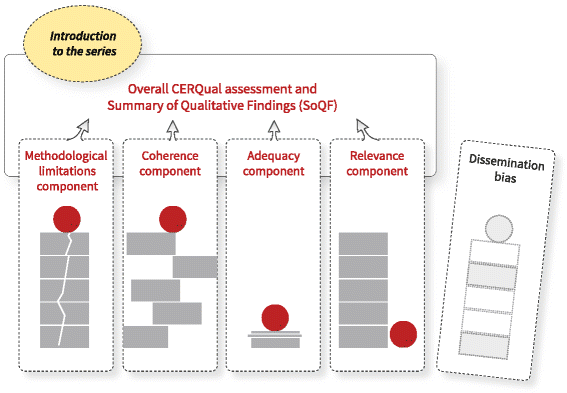Applying GRADE-CERQual to qualitative evidence synthesis findings: introduction to the series
- PMID: 29384079
- PMCID: PMC5791040
- DOI: 10.1186/s13012-017-0688-3
Applying GRADE-CERQual to qualitative evidence synthesis findings: introduction to the series
Abstract
The GRADE-CERQual ('Confidence in the Evidence from Reviews of Qualitative research') approach provides guidance for assessing how much confidence to place in findings from systematic reviews of qualitative research (or qualitative evidence syntheses). The approach has been developed to support the use of findings from qualitative evidence syntheses in decision-making, including guideline development and policy formulation. Confidence in the evidence from qualitative evidence syntheses is an assessment of the extent to which a review finding is a reasonable representation of the phenomenon of interest. CERQual provides a systematic and transparent framework for assessing confidence in individual review findings, based on consideration of four components: (1) methodological limitations, (2) coherence, (3) adequacy of data, and (4) relevance. A fifth component, dissemination (or publication) bias, may also be important and is being explored. As with the GRADE (Grading of Recommendations Assessment, Development, and Evaluation) approach for effectiveness evidence, CERQual suggests summarising evidence in succinct, transparent, and informative Summary of Qualitative Findings tables. These tables are designed to communicate the review findings and the CERQual assessment of confidence in each finding. This article is the first of a seven-part series providing guidance on how to apply the CERQual approach. In this paper, we describe the rationale and conceptual basis for CERQual, the aims of the approach, how the approach was developed, and its main components. We also outline the purpose and structure of this series and discuss the growing role for qualitative evidence in decision-making. Papers 3, 4, 5, 6, and 7 in this series discuss each CERQual component, including the rationale for including the component in the approach, how the component is conceptualised, and how it should be assessed. Paper 2 discusses how to make an overall assessment of confidence in a review finding and how to create a Summary of Qualitative Findings table. The series is intended primarily for those undertaking qualitative evidence syntheses or using their findings in decision-making processes but is also relevant to guideline development agencies, primary qualitative researchers, and implementation scientists and practitioners.
Keywords: Confidence; Evidence-based practice; GRADE; Guidance; Methodology; Qualitative evidence synthesis; Qualitative research; Recommendations for practice; Research design; Systematic review methodology.
Conflict of interest statement
Ethics approval and consent to participate
This is not applicable. This study did not undertake any formal data collection involving humans or animals.
Consent for publication
Not applicable
Competing interests
The authors declare that they have no competing interests.
Publisher’s Note
Springer Nature remains neutral with regard to jurisdictional claims in published maps and institutional affiliations.
Figures
References
-
- Treweek S, Oxman AD, Alderson P, Bossuyt PM, Brandt L, Brozek J, Davoli M, Flottorp S, Harbour R, Hill S, et al. Developing and Evaluating Communication Strategies to Support Informed Decisions and Practice Based on Evidence (DECIDE): protocol and preliminary results. Implement Sci. 2013;8:6. doi: 10.1186/1748-5908-8-6. - DOI - PMC - PubMed
-
- Davies P: Evidence-based government: how can we make it happen? CHSRF (Canada Health Services Research Foundation) 7th annual invitational workshop - leveraging knowledge: tools and strategies for action. Montreal, Canada; 2005.
Publication types
MeSH terms
Grants and funding
LinkOut - more resources
Full Text Sources
Other Literature Sources
Research Materials



